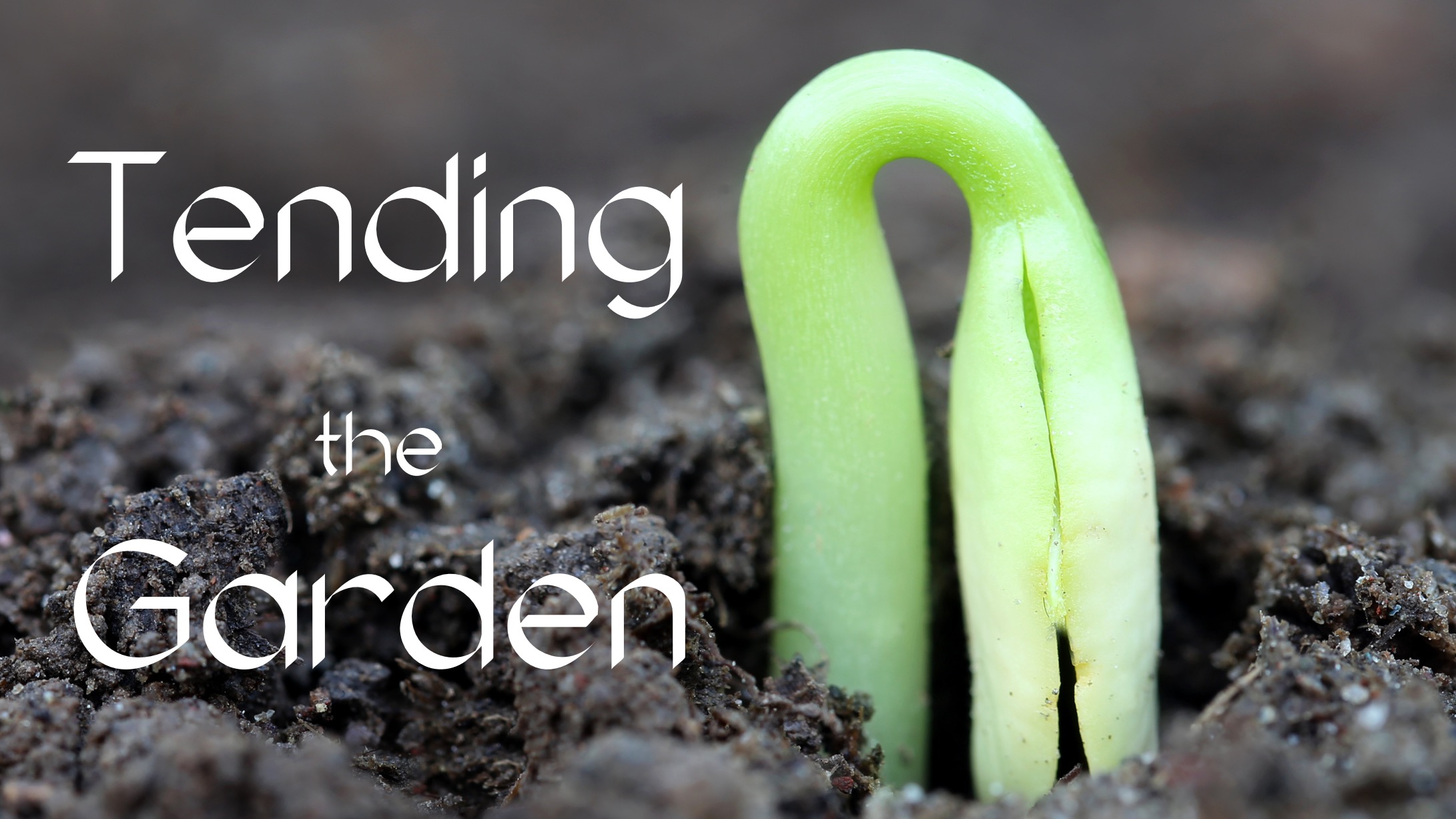
Tending the Garden
“You visit the earth and water it, you greatly enrich it; the river of God is full of water; you provide their grain, for so you have prepared it. You water its furrows abundantly, settling its ridges, softening it with showers, and blessing its growth. You crown the year with your bounty; the tracks of your chariot overflow with richness. The pastures of the wilderness drip, the hills gird themselves with joy, the meadows clothe themselves with flocks, the valleys deck themselves with grain, they shout and sing together for joy” (Psalm 65:9-13).
Symbols hold a place of great significance in theology. A symbol is a representation that helps us to understand the depth of a spiritual reality. As an embodied spirit, the human intellect needs visible, physical symbols to better understand the invisible, immaterial spiritual realm.
The garden is a particular symbol that is found from the very beginning of Sacred Scripture in Genesis to the very end in Revelation. At its core, the symbol of the garden represents creation and humanity’s right-relationship with God. Key attributes of a garden are order, harmony between creatures, stability, beauty, provision, purpose, and nearness to God.
Contrasted with the garden symbol is the symbol of the wilderness. The wilderness symbol represents a place of testing, trial, temptation, competition, and purification. It strips a person down to the heart of who they are and reveals weakness and strength with particular clarity. Spending time in the wilderness is often a place to relearn how to encounter God and to once again attune our minds and hearts to hear His voice.
Grief can be understood through both the garden and the wilderness. In a previous post “The Journey of Grief,” we examined traveling through the wilderness of grief. In “Returning to the Garden,” we expanded on this theme by considering how the desert wilderness of grief is transformed into a place of springs so that our life and relationships can return to a garden environment. The springs of renewal during grief are sheer grace and mercy on God’s part. It is His action that enables us to encounter death, and rather than be crushed and overcome by it, to instead be strengthened and renewed in spirit.
Living in the spiritual reality of the garden requires something of us in response to the gifts of grace and mercy. Like a natural garden, there are rules that we must follow to tend the garden of our grief. It is first helpful to consider the rules of a natural garden so that we can better understand the spiritual elements of the symbolic garden.
- Soil and Light Matter – The condition of the soil is vitally important to growing healthy plants. In order for a seed to take root or a mature plant to thrive, the soil must match the condition proper to a particular plant. It must be well-drained, receive appropriate water, be free of rocks and obstructions, and be free of weeds that will choke the life of a plant. Preparing and maintaining proper soil conditions is crucial to the health and thriving of the plants placed in it. Likewise, the amount of light a plant gets will determine if it grows and thrives or if it withers and dies. Some plants do well with a lot of heat and light, while other plants thrive in the cool of the shade.
- There is No Empty Space in a Garden – The soil was meant to sustain life. The question is, what kind of life will grow there? In the wilderness, whatever is strongest will dominate a plot of land. While there can be a natural beauty about the wilderness, a garden is different. What grows in a garden is chosen and cared for. There is no such thing as “empty space” in a garden. Something will always try and grow in an area not occupied by the roots of a plant. Any soil that can sustain life, will sustain life. Removing and preventing weeds from overtaking the desired plants in a garden is a constant task of any gardener.
- Every Season is Important – Each season has its place in the life and process of a garden. Spring is a time of preparation and promise. Summer is often the season of growth and maturity. Fall brings the harvest and abundance. Even winter is important because it allows the soil and dormant plants to rest and prepare for renewal and growth in the next season. The cycle of seasons is filled with latent potential for beauty and fruitfulness, with each season helping the other seasons.
- Different seasons will produce different fruits – There are two main types of fruit produced in a garden – fruits of provision to sustain us and fruits of beauty to transcend the ordinary and inspire our souls. Knowing what fruit is desired and needed is important in arranging a garden. Fruits of provision do not always look nice, and fruits of beauty cannot sustain life in themselves. To state it another way – the gardener must know the purpose of the garden in order to cultivate the appropriate plants. If provision is needed, planting flowers will not achieve the desired end. If beauty is the goal, then planting only vegetables will fail to enliven and inspire.
In the glory of God’s creation, the natural always points and leads us to the supernatural and transcendent. They are woven together. The spiritual garden mirrors these rules of a natural garden, and are especially important in grief.
The environment we grieve in is an often over-looked element to transforming grief from a prison into a place of love. Just as the soil and sunlight affect the growth of a plant, the conditions and circumstances of our grief matter. It is important through prayer, reflection, and spiritual direction, to identify the things that are helpful or hinderances during grief and to adjust an environment accordingly.
The human person is meant for relationship. Death and grief damage relationships, but they do not eliminate them. It is not healthy to grieve in complete isolation or to try and grieve in a vacuum. While it is true that different individuals may need more or less help, counsel, and presence of others in their grief, ultimately, we are made and meant for relationship. To leave too much empty space during grief provides conditions for “weeds” to take root. These weeds are harmful or detrimental behaviors, attachments, or emotions. It may take professional counseling and spiritual direction to identify and uproot the weeds of grief. This is not a defeat and there is no shame in this. Rather, it is a healthy habit to develop in grief.
Grief is not a simple linear process. This means that grief will often cycle through the same stages or seasons many times. This does not mean that a person “regresses” in their grief because he or she returns to an aspect of grief previously left behind. Grief and loss are dynamic processes and are as complicated as the individuals enduring them. Each season of grief has a purpose in the healing process, and some seasons can be more unpleasant than others. Yet, they each have an important role in the healing process. Allow each season to provide for your grief what only it can offer. Time and grace will allow the individual parts of grief to be woven together into a mended whole.
Finally, grief will produce fruit in a person’s life. Previously, we wrote about the gift death gives to the human condition. So too grief has the ability to give a greater freedom of life and capacity for joy previously unknown. What is required to bear this spiritual fruit are faith, hope and love that God is present to us in our grief and will transform us through our grief into a new creation. The fruit of grief can be hard-fought, and requires great patience in the process, but it is worth it.
The truth of the mystery of the garden and wilderness is that God provides and tends for both landscapes. The natural and unbridled majesty of the wilderness and the cultivated beauty of the garden both have as their purpose drawing us nearer to God. The difference between the two is what our needs are at a given time. Let us each invite the Holy Spirit into our hearts and our grief to allow God to lead us into the wilderness and tend the gardens of our soul to produce His fruit in our lives. In this, we will have the freedom and the joy that we long for!
For Prayer:
Read Matthew 13:1-9,18-23 and reflect upon the current state of your grief.
The soil in this parable can be applied to grief in two ways:
- The pavement, rocks, and thorns (weeds) represent things that hinder our grief. The pavement in grief are those things which have hardened and calloused our souls from receiving compassion, love, and consolation from others and from God. The rocks are anything that prevents anything helpful in healing from becoming habit. The thorns are anything or anyone that is a negative influence in our grief or that prevents us from grieving in a healthy manner. The good soil occurs when all these hindrances are removed and we seek the good seed of counseling, spiritual direction, and consolation offered to us.
- What is preventing my grief from bearing fruit in my life? The first application interpreted the parable in the context of my own healing. Another parallel and equally important application is to understand that God transforms even great evil into good. The Cross and Resurrection of Jesus is the greatest proof of this. Grief, if we let God into it, will be transformed into new and greater life.
Consider both of these applications, and identify the changes you can make in your grief to bring the fruits of healing and new life through your grief. Truly, if God is with us then who and what can be against us and conquer us (cf. Romans 8:31)? May grace, peace and new life be given to each of you in the measure you need it most!


